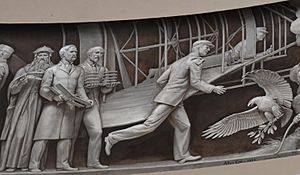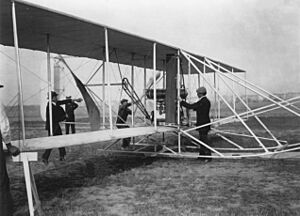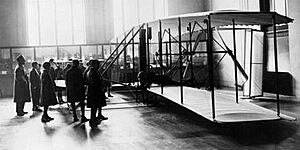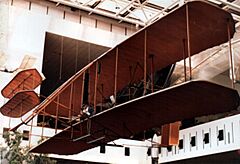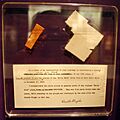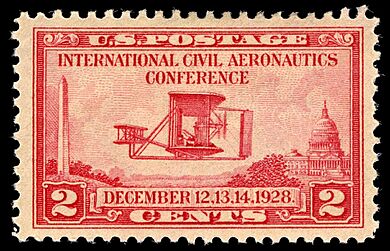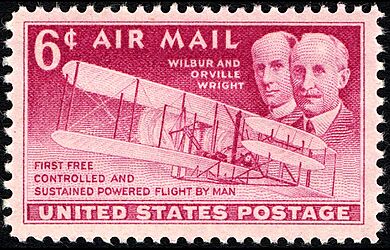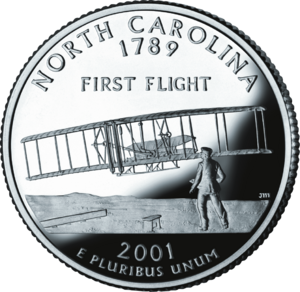Wright Flyer facts for kids
Quick facts for kids Wright Flyer |
|
|---|---|
 |
|
| Seconds into the first airplane flight, near Kitty Hawk, North Carolina, on December 17, 1903 | |
| Role | Experimental airplane |
| National origin | United States |
| Manufacturer | Wright Cycle Company |
| Designer | Orville and Wilbur Wright |
| Number built | 1 |
| Developed from | Wright Glider |
| Developed into | Wright Flyer II Wright Flyer III |
| Career | |
| Other name(s) | Kitty Hawk, Flyer I, 1903 Flyer |
| Manufactured | 1903 |
| First flight | December 17, 1903, 122 years ago |
| Owners and operators | Wright Brothers |
| Last flight | December 17, 1903 |
| Flights | 4 |
| Status | Preserved and displayed at the National Air and Space Museum |
The Wright Flyer, also known as the Kitty Hawk, was the very first airplane to make a successful, controlled flight with a pilot. On December 17, 1903, brothers Orville and Wilbur Wright flew it, starting a new age of flight!
This amazing aircraft was a biplane, meaning it had two main wings, one above the other. It also had a small wing at the front called a canard and two rudders at the back. It used a 12 horsepower gasoline engine to power two propellers located behind the wings. The Wright brothers used a special method called 'wing warping' to steer it, which made the wings twist slightly. This made the Flyer quite tricky to control.
The Wright brothers flew the Flyer four times in Kill Devil Hills, North Carolina. The longest flight covered 852 feet (260 meters). After its fourth flight, the airplane was damaged and never flew again. Today, the original Wright Flyer is kept safe and displayed at the National Air and Space Museum in Washington, D.C..
| Top - 0-9 A B C D E F G H I J K L M N O P Q R S T U V W X Y Z |
Building the First Airplane
The Flyer was built based on what the Wrights learned from testing their gliders between 1900 and 1902. Their last glider, the 1902 Wright Glider, helped them design the Wright Flyer.
The brothers built the aircraft in 1903 using strong wood like spruce and ash. The wings were covered with a special cotton fabric. Since they couldn't find an engine light enough for their plane, they asked their employee, Charlie Taylor, to build one from scratch.
The Engine and Propellers
Charlie Taylor built a lightweight 12 horsepower gasoline engine. It weighed 180 pounds (82 kg) and had a small fuel tank. The engine powered two propellers using chains, similar to those on a bicycle. To make sure the plane flew straight, one chain was crossed so the propellers spun in opposite directions. This helped balance the aircraft.
Taylor explained that the engine took him six weeks to build. It was made of cast aluminum with iron pistons. There was no modern carburetor; fuel flowed by gravity. The spark for the engine was made by contact points inside the combustion chamber.
The propellers were 8.5 feet (2.6 meters) long. They were carefully designed based on the Wrights' wind tunnel tests. Wilbur figured out that slower-turning blades created more thrust, and two propellers were better than one fast-spinning one. The propellers were made from layers of spruce wood and covered with canvas.
Testing the Flyer
In November 1903, the brothers tested their engine at Kitty Hawk. They had some issues with the propeller hubs and shafts, which needed repairs. On December 12, they installed new parts and tested the Flyer on a 60-foot (18-meter) launching rail. This rail had a wheeled dolly that the plane rested on.
The brothers had designed their propellers to create enough thrust to lift the 630-pound (286 kg) machine. In their tests, the propellers produced even more thrust than they expected, which was great news for their 700-pound (318 kg) Flyer.
How the Flyer was Built
The Wright Flyer was a canard biplane. It had a wingspan of 40 feet 4 inches (12.29 meters) and was 21 feet 1 inch (6.43 meters) long. The pilot lay on their stomach on the lower wing to reduce air resistance. The pilot was on the left side, and the engine was on the right.
To steer, the pilot moved a hip cradle. This cradle pulled wires that twisted the wings (wing warping) and turned the rudder at the same time. This allowed for coordinated turns. The pilot used their left hand to control the front elevator, which helped the plane go up or down.
The Flyer launched from a 60-foot (18-meter) track of wooden planks, which the brothers called the "Junction Railroad." The plane sat on a wheeled dolly. A wire held the plane back until the pilot was ready for takeoff.
The Wright Flyer had three simple instruments:
- A recorder to count propeller turns.
- A stopwatch to time the flights.
- A hand anemometer to measure the distance flown.
First Flights at Kitty Hawk
After returning to Kitty Hawk in 1903, the Wrights finished building the Flyer. They also practiced flying their 1902 Glider. By December 14, they were ready for their first powered flight attempt. They moved the Flyer to a sand dune called Big Kill Devil Hill.
Wilbur won a coin toss to be the first pilot. He took off, but pulled up too sharply, causing the plane to stall and land quickly. It flew 105 feet (32 meters) in 3.5 seconds and had only minor damage.
Repairs took three days. On December 17, the wind was strong, so they set up the launching rail on flat ground, facing into the wind. This time, the wind helped the plane get enough speed to take off. Orville took his turn at the controls. His first flight lasted 12 seconds and covered 120 feet (37 meters).
That day, the Wrights made four short, low flights. They flew in a straight line and didn't try to turn. Each flight ended with a bumpy landing. The last flight, piloted by Wilbur, was the longest, covering 852 feet (260 meters) in 59 seconds. After this flight, the front elevator supports were broken.
Soon after, a strong gust of wind picked up the Flyer and tumbled it over. The damage was too severe for quick repairs, and the plane never flew again.
In the following years, the Wrights kept improving their designs. They built the Wright Flyer II in 1904 and the Wright Flyer III in 1905. With the Flyer III, Wilbur made a 39-minute flight, covering 24 miles (39 km) in circles.
Impact of the Wright Flyer
The Flyer aircraft series were the first to achieve controlled flight. While some of the Wrights' mechanical methods weren't widely adopted, their ideas about how to control an aircraft were very important. The Flyer used wing-warping and a front elevator, which were hard to scale up for bigger planes.
However, the Wrights' idea of twisting the wings to control roll (side-to-side motion) led to the invention of ailerons by others. Their discovery in 1902 of how to coordinate roll and yaw (turning the plane left or right) is still used in almost every airplane today. The Wrights' success also came from their efficient wings and propellers, which they designed using careful wind tunnel tests.
For a while, the Wright Brothers didn't publicize their flights much. Other aviators, like Alberto Santos-Dumont, were thought by some to have flown first. But after their successful public demonstration in France in 1908, the Wrights were recognized as the true pioneers of flight.
In 1909, the Wright Military Flyer became the world's first military aircraft. It was used to train pilots and test new aviation ideas. Later, the Wright Model B was produced in larger numbers and used for training and experiments, including testing bombsights.
The Wrights also fought legal battles over their patents, trying to protect their invention. This legal fighting actually slowed down the growth of the American aircraft industry for a while.
How Stable Was It?
The Wright Flyer was designed more for control than for stability. It was known to be unstable and quite difficult to fly. The Wrights even added weight to the front of the plane to help make it more stable. Early flights often suffered from the pilot over-controlling the plane because the front elevator was very sensitive.
After Kitty Hawk
After their historic flights, the Wright Brothers shipped the damaged Flyer back to their home in Dayton, Ohio. It stayed stored in crates for nine years. In 1913, a big flood covered the Flyer in mud and water.
In 1910, the Wrights offered to display the Flyer at the Smithsonian Institution, but the Smithsonian turned them down. After Wilbur died in 1912, Orville prepared the Flyer for display at the Massachusetts Institute of Technology. He replaced some parts, including the wing covering and parts of the engine.
Disagreement with the Smithsonian
For many years, the Smithsonian Institution did not fully credit the Wright Brothers for the first controlled flight. Instead, they honored a former Smithsonian leader, Samuel Pierpont Langley, whose aircraft, the Aerodrome, had failed its tests in 1903. This was partly because a friend of Langley, Charles Walcott, was in charge of the Smithsonian at the time.
In 1914, Glenn Curtiss, who was in a patent dispute with the Wrights, tried to prove that Langley's machine could fly. He made many changes to the Aerodrome and managed to make it hop a few feet off a lake for short periods. Critics argued these were not just "restorations" but major changes to the original design.
Between 1916 and 1928, Orville supervised the Wright Flyer's display at various events. In 1925, Orville tried to pressure the Smithsonian by threatening to send the Flyer to the Science Museum in London. The Smithsonian didn't change its mind, so in 1928, Orville shipped the Kitty Hawk to London, where it was displayed in a place of honor. It stayed there for 20 years, except during World War II when it was moved for safety.
In 1942, a new secretary at the Smithsonian, Charles Greeley Abbot, finally admitted that the Aerodrome had been heavily modified by Curtiss. He also publicly stated that the Wright brothers were indeed the first to make sustained flights. He promised that if Orville returned the plane, it would be given the highest honor.
The next year, Orville agreed to bring the Flyer back to the United States. However, he included a special condition: the Smithsonian could not claim that any earlier aircraft was capable of controlled, powered flight with a pilot.
On October 18, 1948, the Kitty Hawk was officially handed over to American officials in London. On November 11, 1948, it arrived in North America aboard the ship Mauretania. From there, it was transferred to a US Navy aircraft carrier, the USS Palau, and then by truck to Washington, D.C.
At the Smithsonian
The Wright Flyer was put on display at the Smithsonian on December 17, 1948, exactly 45 years after its first flights. Orville Wright had passed away earlier that year and did not live to see it. In 1976, it moved to the new National Air and Space Museum. Since 2003, it has been in a special exhibit celebrating the 100th anniversary of its first flight.
Restoring the Flyer
By 1981, the Wright Flyer needed restoration after many years on display. The fabric covering was discolored, and metal parts showed corrosion. In 1985, work began to restore it, supervised by experts. The restoration was done in public view.
The wooden frame was cleaned, and corrosion was removed from metal parts. Only the fabric covering was replaced with a new one that was more accurate to the original. The engine's original paint was preserved. This restoration was planned to last for 75 years.
Replicas of the Flyer
Many replicas of the Wright Flyer have been built. In 1978, Ken Kellett built one and flew it at Kitty Hawk for the 75th and 80th anniversaries of the first flight.
For the 100th anniversary in 2003, a group called The Wright Experience built a very accurate reproduction. They tried to recreate the original flight on December 17, 2003, but bad weather prevented a successful flight that day. This reproduction is now at the Henry Ford Museum in Michigan.
The Los Angeles Section of the American Institute of Aeronautics and Astronautics (AIAA) also built a full-scale replica between 1979 and 1993. This replica was used for wind tunnel testing to learn more about the Flyer's aerodynamics. It is now displayed at the March Field Air Museum in California. Many other non-flying replicas are displayed around the world.
-
The AIAA's Flyer replica being tested in a NASA wind tunnel.
-
Wright Flyer Replica at the Henry Ford Museum.
-
Flyer replica at the Frontiers of Flight Museum.
Flyer Artifacts in Space
Pieces of the original Wright Flyer have traveled to amazing places!
- In 1969, parts of the original fabric and wood went to the Moon with Neil Armstrong on Apollo 11. They were on the Lunar Module Eagle that landed on the Moon. This artifact is now at the visitors center at the Wright Brothers National Memorial.
- In 1986, other pieces of wood and fabric, along with a note from Orville Wright, were on the Space Shuttle Challenger mission STS-51-L. Sadly, the Shuttle was destroyed after liftoff. These pieces were recovered and are on display at the North Carolina Museum of History.
- A small piece of the Wright Flyers wing fabric is attached to the Ingenuity helicopter, which became the first aircraft to fly on Mars in 2021. Ingenuitys first landing spot on Mars was even named Wright Brothers Field.
-
Wright Flyer wood and fabric taken to the Moon in 1969 by Neil Armstrong aboard Apollo 11.
-
Wright Flyer wood, fabric, and a note by Orville Wright taken aboard Space Shuttle Challenger's 1986 flight.
-
A piece of Wright Flyer's wing fabric is attached to the Ingenuity helicopter, the first powered aircraft to fly on Mars.
Wright Flyer Facts
General characteristics
- Crew: 1
- Length: 21 ft 1 in (6.43 m)
- Wingspan: 40 ft 4 in (12.29 m)
- Height: 9 ft 0 in (2.74 m)
- Wing area: 510 sq ft (47 m2)
- Empty weight: 605 lb (274 kg)
- Max takeoff weight: 745 lb (338 kg)
- Powerplant: 1 × Wright straight-4 water-cooled 201.1 cu in (3,295 cc) piston engine., 12 hp (8.9 kW)
- Propellers: 2-bladed Wright "Elliptical" props, 8 ft 6 in (2.59 m) diameter
Performance
- Maximum speed: 30 mph; 26 kn (48 km/h)
- Service ceiling: 30 ft (9.1 m)
- Wing loading: 1.4 lb/sq ft (6.8 kg/m2)
- Power/mass: 0.02 hp/lb (15 W/kg)
Commemorating the Flyer
The Wright Brothers and their airplane have been honored on U.S. coins and postage stamps.
See Also
- Aircraft related to this one
- The Wrights' unpowered gliders
- 1902 Glider
- Flyer II
- Flyer III
- Wright Model A
- Wright Model B


